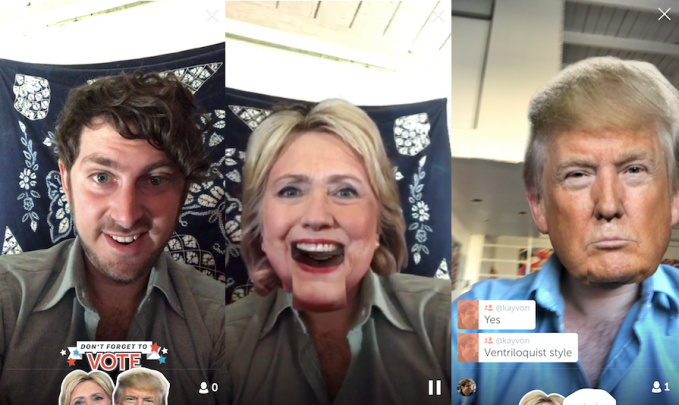Periscope is following Snapchat and Facebook’s lead by creating its own animated augmented reality selfie masks. The first ones can make you look like Hillary Clinton or Donald Trump, and will be available for the next week for the election. If you broadcast in selfie mode with the iOS app’s latest version, you’ll see them docked at the bottom of the screen. Tapping them automatically adds them to your face, and you can get a friend in frame to use both masks at the same time.
A Twitter spokesperson tells me “They’re just meant to be an entertaining way to have convos around the election and a reminder for everyone to vote.” Periscope CEO Kayvon Beykpour tells me “They’re fun and it made sense for this use case”.
Periscope reveals these aren’t the only creative tools it’s working on, writing “These Election Day masks are a lighthearted example of the types of tools our team is working on to help you create compelling live video. We’re excited to bring you more advanced tools soon.” Periscope added its first creative tool, overlaid drawing, back in April. The election masks won’t be coming to Android but future creative tools might.
Unlike the illustrated masks seen on other services, Periscope’s Hillary and Trump masks are essentially photos with moving mouths that stick to your face wherever it moves. In fact, Periscope credited the photographers in its announcement, “Masks image credit:“Hillary Clinton with Supporters” by Gage Skidmore, used under CC-BY-SA 2.0/ modified from original; “Donald Trump” by Gage Skidmore, used under CC-BY-SA 2.0/ modified from original.”
The masks, which Beykpour described as “ventriloquist style”, look a bit like JibJab’s cartoons. When asked why, he said “because we think Jib Jab is entertaining and fun.”

Hands-on with Periscope masks
Selfie masks could make users feel more comfortable broadcasting on Periscope because they obscure their faces. Shyness is a top factor discouraging users from getting on camera, which is why Snapchat has made them the flagship feature of its app, and Facebook quickly copied them by acquiring selfie mask startup MSQRD and later adding them to Facebook Live.
Now Periscope won’t be left out. While serious citizen journalism and expert Q&A’s have been Periscope’s core uses, branching out into more playful territory could attract a mainstream audience. If Periscope adds more masks, or launches filters and other effects, it could get people to stream even if they’re having a bad hair day or look a little haggard.

That’s Periscope CEO Kayvon Beykpour on the right
The question will be whether Periscope can keep up. Snapchat and Facebook both acquired selfie mask startups to jumpstart their features, and have been aggressively hiring augmented reality engineers. Periscope’s comparatively lean operation within its financially strapped parent company Twitter may not be able to build accurate object recognition and tracking or design as many zany masks as quickly.
But at least getting the first masks out the door helps Periscope show its intent to adopt augmented reality, which reduces differentiation for its competitors and could attract AR talent to the company.
